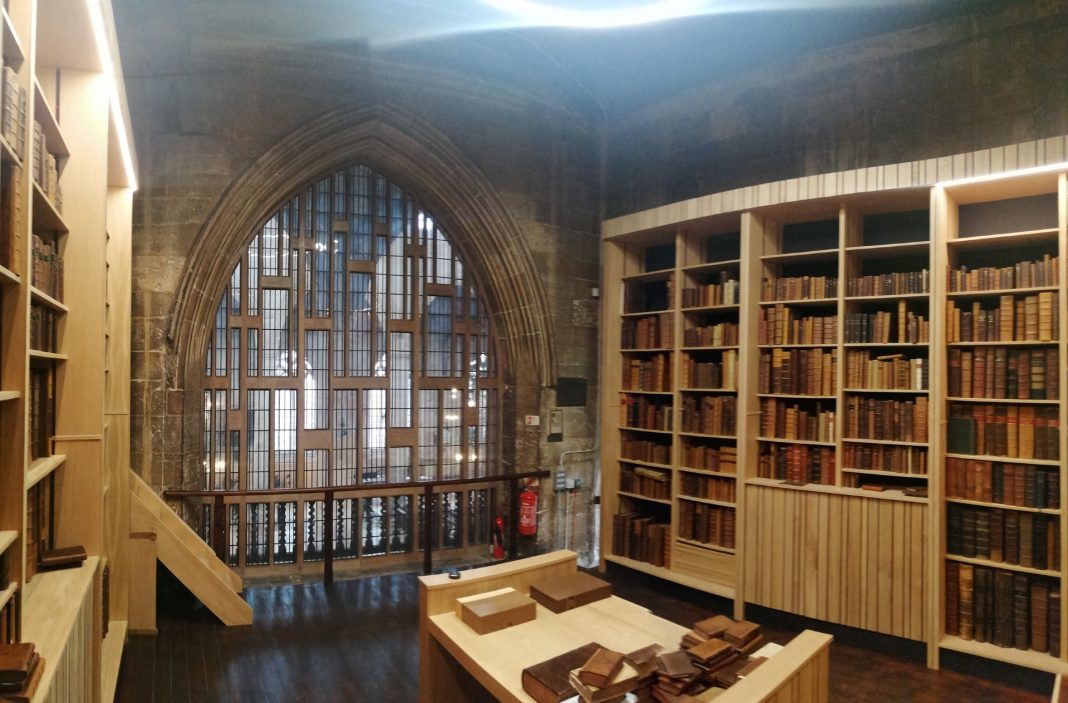A Nottinghamshire firm that specialises in reducing the carbon footprint of buildings has been praised by the Princess Royal for helping to preserve a rare collection of books in an historic church library.
Viridis, based in Collingham, near Newark, recently completed work to optimise energy efficiency, costs, UV exposure and humidity control at St Botolph’s Church, in Boston, Lincolnshire.
Part of the medieval church, also known as the Boston Stump, houses a library containing around 1,200 historic books that are often sought after by academics.
One of the books – St Augustin’s Commentary on Genesis – dates back to 1170, and it had been feared that over-exposure to natural light, temperature and humidity variations, would permanently damage an important part of our literary history.
Viridis was therefore commissioned by the Boston Stump Restoration Trust to design a new energy system that would help to preserve the books for enjoyment by future generations.
The finished project, which also included improving energy efficiency in the main church and neighbouring Blenkin Memorial Hall, was inspected by the Trust’s patron, Princess Anne, on a recent visit.
Lee Marshall, managing director of Viridis, said: “Princess Anne accompanied me to the library with just a small handful of other staff and proceeded to spend 25 minutes discussing the improvements we had designed.
“I was amazed at her deep level of interest – she was really keen to find out more about what we had done. And she was extremely impressed by the achievement.”
Lee said that the first thing his team of scientists, architects and engineers did on an important heritage asset like St Botolph’s was to understand how the building worked as “a piece of technology.”
The next stage is figuring out how the team can optimise the internal environment while at the same time reducing the level of mechanical and electrical services that go into running the various parts of the building.
“In terms of the library, which is a relatively small space, it was receiving too much natural light through its large, ornate south-facing window and two smaller windows, so we had to address that as it was damaging the books,” he said.
“With its thick stone walls, which can keep heat in as well as out, we also manipulated physics to ensure the internal temperate remains at a moderate 17 degrees – which is not too cold and not too hot for the delicate books.”
The excess of natural light in the library was reduced by building bookshelves in front of the two smaller windows and installing louvre blinds in the large window, which can be manually controlled by staff according to needs.
Viridis also installed a humidification unit, about the size of a small filing cabinet, to ensure the air was not too wet and not too dry, both of which can damage ancient books.
“As engineers, we work with the environment,” said Lee. “Instead of wasting energy by using a third-party water source in the event that the air is too dry, our unit stores and utilises the free moisture that exists in the atmosphere. It is these small details that help to provide our clients with the big benefits.”
In the main St Botolph’s Church, parts of which date back to 1309, Viridis re-ordered the heating system. It reduced the building’s boiler capacity by 50 per cent and reduced its operation and energy use by up to 400 per cent, vastly increasing energy efficiency and reducing emissions.
As a result, the building is now much warmer than before, it costs less to heat and, significantly, the church has reported a huge increase in visitor numbers, which it puts down to the warmer environment inside.
“It’s now warmer and therefore more welcoming, which was a very important part of our brief,” said Lee. “The church as a whole is now far more sustainable, and we have created an environment in the library that saves some very historic books. I’d like to thank the team at St Botolph’s for their vision and support.”
Other important books housed in St Botolph’s Library include a 1542 edition of the works of Geoffrey Chaucer, a Book of Common Prayer printed in 1549 and a collection of books by Dutch philosopher Erasmus, published between 1545 and 1548.



